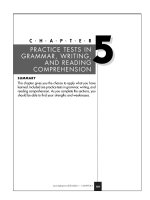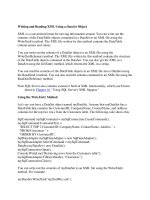Technical writing and presentation
Bạn đang xem bản rút gọn của tài liệu. Xem và tải ngay bản đầy đủ của tài liệu tại đây (1.81 MB, 31 trang )
Technical Writing
And
Presentation
How to have a good
technical writing and
presentation
Lecturer : Tran Van Huong, D.Sc.
Student : Pham Tuan Vu
2
What is the purpose of a
research paper?
Share knowledge gained with other researchers
. Show how your study fits into current science
. Inform the public about importain scientific activity
3
Important Factors of
Research Writing Quality
COHERENCE
01
. Include all necessary information in each section
. Do not repeat information unless necessary
ORGANIZATION
02
RELEVANCE
. Conform to length guidelines and keep paper focused
. Choose a limited amount of data to present in each section
03
04
4
. Follow IMRD structure
. Put the right parts in the right place
Clarity
. Should be easy to read and understand
. Use proper grammar, phrasing, and style
◇
Research Writing Structure
Methods
Discussion
Conclusion
Introduction
IMR&D
5
Results
How to Start
and Complete a
Research Paper
Chose a Topic
Your job will be more pleasant, and you will be more apt to retain
information if you choose a topic that holds your interest.Even if a
general topic is assigned, as much as possible find an approach
that suits your interests. Your topic should be one on which you
can find adequate information, you might need to do some
preliminary research to determine this.
Preliminary reading &
Recordkeeping
Gather a small notebook and keep them with you as you read. First
read a general article on your topic. In the notebook, record the author,
article and/or book title, and all publication information in the correct
format. In your notebook, write down information you want to use from
each identified source, including page numbers.
8
Organizing: Mind map or Outline
Based on your preliminary reading, draw up a working mind map
or outline. Include any important, interesting, or provocative
points, including your own ideas about the topic. A mind map is
less linear and may even include questions you want to find
answers to. You may revise this mind map or outline at any time;
it is much easier to reorganize a paper by crossing out or adding
sections to a mind map or outline than it is to laboriously start
over with the writing itself.
9
Formulating a thesis: Focus and
Craftsmanship
Write a well defined, focused, three- to five-point
thesis statement, but be prepared to revise it later if
necessary. Take your time crafting this statement
into one or two sentences, for it will control the
direction and development of your entire paper.
10
Researching: Facts and Examples
Try the internet, electronic databases,
reference books, newspaper articles, and
books for a balance of sources. Write
important points, details, and examples,
always distinguishing between direct quotes
and paraphrasing. Avoid relying too heavily on
internet sources, which vary widely in quality
and authority and sometimes even disappear
before you can complete your paper.
11
Rethinking: Matching mind Map and
Thesis
After you have read deeply and gathered plenty
of information, expand or revise your working
mind map or outline by adding information,
explanations, and examples. Aim for balance in
developing each of your main points. Return to
the library for additional information if it is
needed to evenly develop these points, or
revise your thesis statement to better reflect
what you have learned or the direction your
paper seems to have taken.
12
Drafting: Beginning in the middle
Write the body of the paper, starting with the
thesis statement and omitting for now the
introduction (unless you already know
exactly how to begin, but few writers do).
Use supporting detail to logically and
systematically validate your thesis statement.
13
Revising: Organization and
Attribution
Read, revise, and make sure that
your ideas are clearly organized
and that they support your thesis
statement. Check that you have
quoted and paraphrased
accurately, and that you have
acknowledged your sources even
for your paraphrasing.
14
Writing: Intro,
Conclusion,
and Citations
15
Add a one-paragraph introduction and a oneparagraph conclusion. Usually the thesis
statement appears as the last sentence or two
of the first, introductory paragraph. The
conclusion should not simply restate your
thesis, but should refer to it.
Proofreading: Time and Objectivity
Time permitting, allow a few days to elapse
between the time you finish writing your last draft
and the time you begin to make final corrections.
This "time out" will make you more perceptive,
more objective, and more critical. On your final
read, check for grammar, punctuation, correct
word choice, adequate and smooth transitions,
sentence structure, and sentence variety
16
How can you make a
good presentation even
more effective?
17
After
Presentation
Presentation
18
Slide
Content
After The
Presentation
Practive
19
Content
- Brainstorm and outline: What's your topic?
What do you know about the topic? What do
you want your audience to know?
- Clearly define the points of the presentation
- Research: Use research to support your
argument, find examples and statistics, or to
learn more about your topic.
- Write an Outline
- Check the main points are in logical order and
flow well
- Prepare speaker notes
20
After The
Presentation
Slide
Create a consistent and simple
design template.
After The
Presentation
21
Slide
Simplify and limit the number of words on
each slide.
After The
Presentation
22
Slide
Use contrasting colors for text and
background.
After The
Presentation
23
Slide
Use good-quality images
After The
Presentation
24
Practive
Practice with someone who has never
seen your presentation
Know how to use your tools.
Plan your outfit.
25
After The
Presentation









